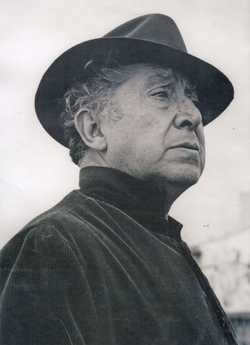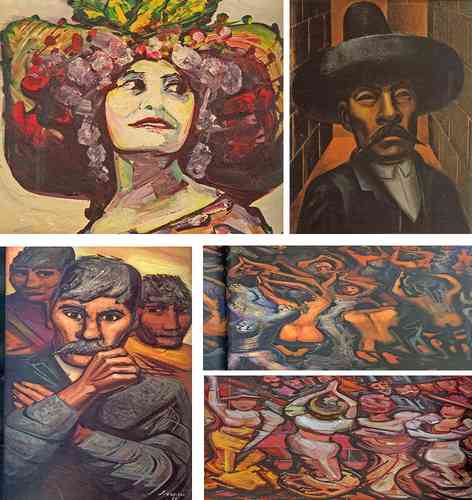Expert raises the urgency of having an analytical catalog of Siqueiros' work

Expert raises the urgency of having an analytical catalog of Siqueiros' work
Tomorrow Irene Herner will present Testimony of a Creative Process, in which she addresses 57 paintings by the muralist // Over time, this artist revolutionizes, becomes current
, she asserts
Merry Macmasters
La Jornada Newspaper, Tuesday, July 1, 2025, p. 2
An analytical
catalog of the work of David Alfaro Siqueiros (1896-1974) is what specialist Irene Herner hopes will spark in Siqueiros Documentado: Testimonio de un Proceso Creativa (Siqueiros Documented: Testimony of a Creative Process), a book that analyzes 57 of the muralist's paintings. To this end, she collaborated with Mónica Ruiz. With more than three decades of research into Siqueiros, Herner has located more than 700 pieces from his output—some are still missing—of which she has documented more than 200.
It would be ideal
if the book published by the National Institute of Fine Arts and Literature, to commemorate the half-century since the artist's death, would make people realize the richness of having an analytical catalog of Siqueiros's work, which is a national artistic monument
. Analytical, not reasoned, because it would encompass the painter's entire oeuvre. It could be done online, Herner suggests, because that way it can be added to.
Author of three books on the muralist, the academic considers Siqueiros documented a kind of distillation of more than 30 years of research
, which stems from having had the opportunity to "get to know his work from my parents' house – Óscar and Trude Herner were owners of the Iturbide gallery – and having met Siqueiros personally for a short time."
Specializing in Mexican muralism, Herner has focused on this painter because he is so well-known, revered, yet so underappreciated as a great artist
. Furthermore, "there has been a lot of uncertainty regarding his output. There's a huge market for pieces that can't be attributed to the master. If we can, it's not clear what his great work as a 'painter of painters' was. In other words, Siqueiros is one of the most important artists of the 20th century, because time doesn't end him; on the contrary, it revolutionizes him, makes him relevant, because the time of art is circular."
Over the years, "I've found many easel works that Siqueiros called 'mobile studies or murals,' because he said he wasn't an easel painter. However, on the one hand, his political circumstances, his exiles, and imprisonments meant he couldn't always paint murals. He continued to experiment through works we call 'easel paintings.'"
A Gershwin commission
The muralist thought these pieces would disappear in private homes
, and considered all of his masterpieces to be photogenic
. That is, made to be mechanically reproduced, photographed, filmed, and animated. Indeed, if you photofilm and animate his work, you find a very interesting narrative
. For Donald Duck to move
, for example, you have to make several drawings to generate movement. Siqueiros learned that he could achieve this effect with a single image, although made in such a way that if the viewer walks in front of it and crosses it, it splits
.

▲ David Alfaro Siqueiros after completing his mural The March of Humanity, in 1971. Photo taken from the book Siqueiros Documentado
Herner's research has yielded some real discoveries. One is the discovery of the treasure
Self-Portrait with Mirror (1937), a work commissioned by the famous pianist and composer George Gershwin, which had been lost
for 80 years.
“In my book Siqueiros: From Paradise to Utopia (2010), I wrote a short chapter based on a photocopy of a photograph of the work. Suddenly, one day, Mary-Anne Martin, from the New York gallery of the same name, called me to say: 'Look, at the home of one of Gershwin's nephews, we found a painting that I think you'd be interested in.' I traveled to New York with my husband and Mónica Ruiz.”
For Herner, the relevance of the work, executed in pyroxylin on Bakelite, lies in the fact that it encapsulates his entire approach to an artist who integrates the languages of new media with those of painting
. It currently belongs to the Museum of Fine Arts, Boston.
Another find was La peladita (1958), made of pyroxylin on masonite. Herner writes about it: The posture of this figure is distorted, it is an extreme foreshortening that makes us travel from the contortion of the Olmec wrestler that Siqueiros admired in the Museum of Anthropology, passing through the monumental figures of the Renaissance and Mannerism, through the moving bodies of Baroque art, through the synthetic space of Cubism, until achieving the fusion of painting with the language of animation and cinema
.
David Alfaro Siqueiros had a troubled and complicated
life. His public and political life has been discussed far more than his artistic work. It must be understood that he was a political artist, not an activist; that he didn't even paint as an activist, but as a great painter. He believed that it was necessary to be a great painter to appeal to the masses, one who not only had good intentions but was also a structured, experimental artist, one who had brought about a technical revolution in art. In other words, revolutions didn't only occur on the battlefields, in politics and economics, but also in art
.
Something that marked Herner is how Siqueiros was consistent with what he proposed in life, as a painter, politician, soldier and thinker
.
Siqueiros's work will be presented tomorrow at 7 p.m. in the Manuel M. Ponce Room of the Palace of Fine Arts.
Revolutionary art muralist

▲
La Jornada Newspaper, Tuesday, July 1, 2025, p. 3
In the usual sense, the paintings De coreografía (portrait of Ofelia Guilmáin), 1962; Retrato de Zapata, 1931; Zapata, 1959; detail of the mural Apology of the Future Victory of Medical Science Against Cancer: Historical Parallelism of the Scientific Revolution and the Social Revolution, painted by the Chihuahua artist in 1958 and housed in the Siglo XXI Medical Center in Mexico City, and La Conesa, 1958, all images taken from the book Siqueiros documented: Testimony of a creative process, by Irene Herner, published by Inbal, which will be presented tomorrow in the Manuel M. Ponce room of the Palacio de Bellas Artes
jornada



%3Aformat(jpg)%3Aquality(99)%3Awatermark(f.elconfidencial.com%2Ffile%2Fbae%2Feea%2Ffde%2Fbaeeeafde1b3229287b0c008f7602058.png%2C0%2C275%2C1)%2Ff.elconfidencial.com%2Foriginal%2F35f%2F2f5%2F413%2F35f2f54135fa47ea2fc33f45b8c9e117.jpg&w=1280&q=100)